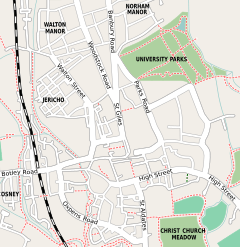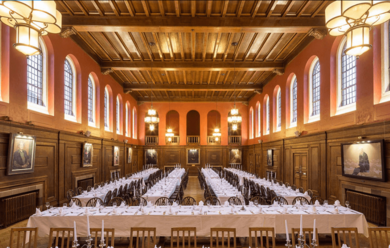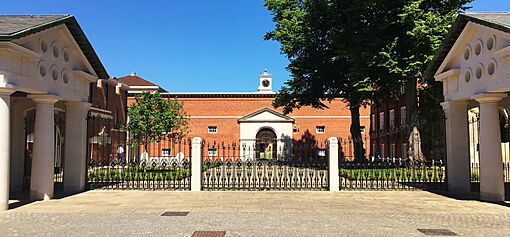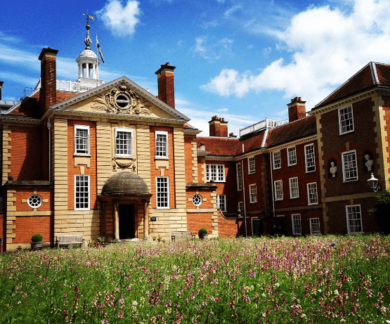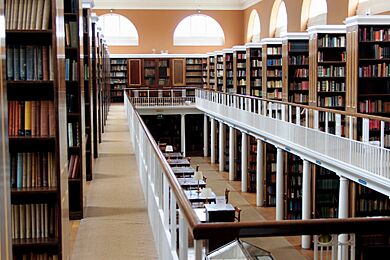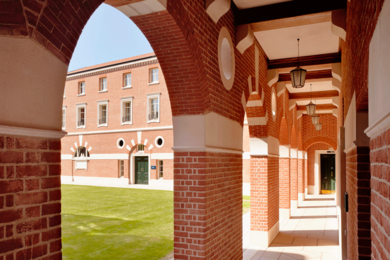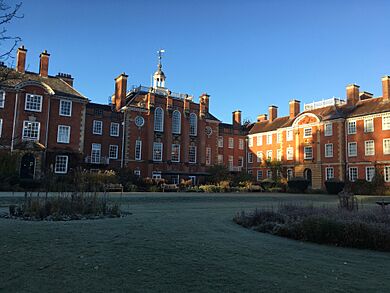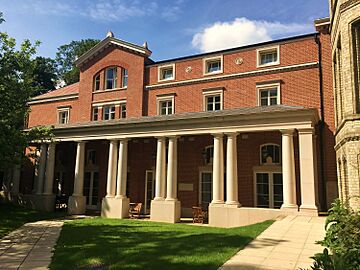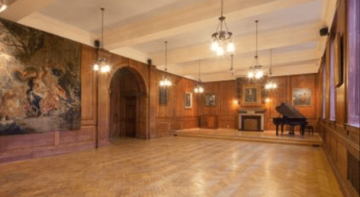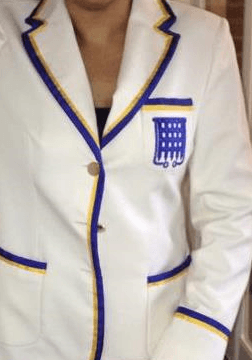Lady Margaret Hall, Oxford facts for kids
Quick facts for kids Lady Margaret Hall |
||||||||||||
|---|---|---|---|---|---|---|---|---|---|---|---|---|
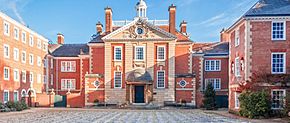 |
||||||||||||
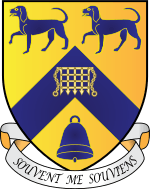
Blazon: Or, on a chevron between in chief two talbots passant and in base a bell azure a portcullis of the field.
|
||||||||||||
|
|
||||||||||||
| University | University of Oxford | |||||||||||
| Location | Norham Gardens, Oxford OX2 6QA | |||||||||||
| Coordinates | 51°45′53″N 1°15′15″W / 51.76483°N 1.254036°W | |||||||||||
| Full name | The College of the Lady Margaret in the University of Oxford | |||||||||||
| Latin name | Aula Dominae Margaretae | |||||||||||
| Motto | Souvent me Souviens (Old French) | |||||||||||
| Motto in English | I often remember | |||||||||||
| Founders | Lavinia and Edward Talbot | |||||||||||
| Established | 1878 | |||||||||||
| Named for | Lady Margaret Beaufort | |||||||||||
| Sister college | Newnham College, Cambridge | |||||||||||
| Principal | Stephen Blyth | |||||||||||
| Undergraduates | 400 (2022/2023) | |||||||||||
| Postgraduates | 325(2022/2023) | |||||||||||
| Map | ||||||||||||
Lady Margaret Hall (often called LMH) is one of the colleges at the University of Oxford in England. It sits by the River Cherwell in north Oxford, right next to the University Parks. The college is officially known as "The Principal and Fellows of the College of the Lady Margaret in the University of Oxford."
LMH was started in 1878 and opened its doors in 1879. It was one of the first two colleges in Oxford for women, along with Somerville College. In 1979, LMH became the first women's college to also welcome men. Today, it has about 400 undergraduate students and around 200 postgraduate students.
In 2016, LMH started a special Foundation Year program. This program helps students from less privileged backgrounds get ready for university. It's the only college in Oxford or Cambridge to offer such a program.
The college's colors are blue, yellow, and white. Its motto is "Souvent me Souviens" which means "I often remember" in Old French. This motto belonged to Lady Margaret Beaufort, who helped start colleges at Cambridge University. Lady Margaret Hall is named after her.
The current head of the college, called the Principal, is Stephen Blyth. Many famous people have studied at LMH, including Benazir Bhutto, Michael Gove, Nigella Lawson, and Malala Yousafzai.
Contents
- Discovering Lady Margaret Hall's History
- The Foundation Year Program
- Exploring Lady Margaret Hall's Buildings
- Gardens and Green Spaces
- Student Life at LMH
- Art and Creativity at LMH
- Understanding the College's Coat of Arms
- Famous Deneke Talks
- Traditions and Culture at LMH
- Famous People from Lady Margaret Hall
- See also
Discovering Lady Margaret Hall's History
How Lady Margaret Hall Began
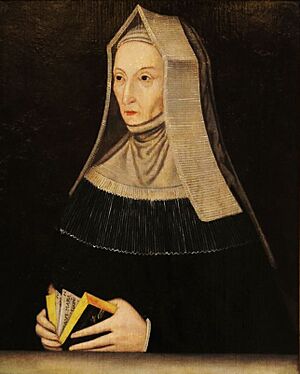
In 1878, a group called the Association for the Higher Education of Women was formed. They wanted to create a college for women in Oxford. Some members wanted a college linked to the Anglican church. Others wanted a college open to everyone, regardless of religion.
Because of these different ideas, the group split. One part started Lady Margaret Hall, which had Anglican roots. The other part started Somerville College. Lady Margaret Hall welcomed its first nine students in 1879. These early students, along with those from Somerville, attended classes in rooms above a bakery.
The college was named after Lady Margaret Beaufort. She was the mother of King Henry VII and a big supporter of education. The first head of the college was Elizabeth Wordsworth. She was the great-niece of the famous poet William Wordsworth.
Growing and Changing Over Time
In 1894, a new building opened, and the college grew to 25 students. LMH bought the land it stands on from St John's College in 1894. This showed the college's plan to build proper educational buildings.
In 1897, people from Lady Margaret Hall started the Lady Margaret Hall Settlement. This was a charity project where graduates lived in a poor area of London. They worked to help people there and create new opportunities.
Before 1920, the university did not give degrees to women. Women were not seen as full members of the university. But in 1920, the first women graduated from LMH. The head of the college, Henrietta Jex-Blake, even received an honorary degree.
During Second World War, many students and staff helped with the war effort. They became nurses, firefighters, and ambulance drivers. Students also grew vegetables on the Fellows' Lawn to help with food supplies.
In 1979, exactly 100 years after it was founded, LMH started accepting men. It was one of the first women's colleges to do this.
Notable People Who Studied Here
In 1919, J. R. R. Tolkien, the author of The Lord of the Rings, taught students at LMH. His daughter, Priscilla Reuel Tolkien, later studied at the college and graduated in 1951.
Harper Lee, who wrote To Kill a Mockingbird, was a visiting student at LMH in 1948.
In 2017, Malala Yousafzai became a student at LMH. She is the youngest person to win the Nobel Peace Prize. She is famous for campaigning for girls' education. She graduated in 2020.
The Foundation Year Program
Lady Margaret Hall is the only Oxford college that offers a foundation year. This program helps students from diverse backgrounds get into Oxford. It has lower entry requirements than the usual Oxford courses.
Students choose a subject to focus on. They also take classes in study skills and other general subjects. The goal is for them to continue to an undergraduate degree at LMH after one year. Students live in the college and use all the same facilities as other students.
This program started in 2016 with 10 students. Seven of them went on to study at Oxford. The others received offers from other top universities. Many people have praised this program for being innovative and important.
Exploring Lady Margaret Hall's Buildings
The college buildings have grown over time, starting from one end of Norham Gardens and moving towards the river. Then, they curve back, forming courtyards. When you enter the college, you can see how old and new buildings stand side by side.
Leatare Quadrangle: Old and New
The Leatare Quadrangle was finished in 2017. It has both the college's newest and oldest buildings. The main entrance has grand gates and the porters' lodge, built in 2017. The Donald Fothergill Building (2017) has student rooms. The Clore Graduate Centre (2017) is for graduate students.
The oldest buildings are on the South East side. The college's first house is called Old Old Hall. The red-brick part next to it is New Old Hall (1884). Old Old Hall used to have the college chapel.
The Wolfson West building (1964) is opposite the entrance. It used to be the main entrance to the college. The MCR, a common room for graduate students, is in the Clore Graduate Centre. It is named after Benazir Bhutto, who was the first female Prime Minister of Pakistan and studied at LMH.
Wolfson Quadrangle: Classic Style
The main early buildings, like Talbot and Wordsworth, were designed by Sir Reginald Blomfield. He used a French Renaissance style with red brick and white stone. This style set the look for many later college buildings.
The central building, the Talbot Building (1910), has Talbot Hall and the Old Library. Student and tutor rooms are in the Wordsworth Building (1896), the Toynbee Building (1915), and the Lodge Building (1926).
Talbot Hall has beautiful oak walls. It used to be the dining hall. Now, it hosts music nights and other college events.
The Lynda Grier building (1962) holds the college library. Queen Elizabeth II officially opened it in 1961. The library was very important because women were not allowed to use the main university library (the Bodleian Library) for a long time. It has a special room for rare books, including a Quran from around 1600.
The Wolfson Quadrangle is special because it has wild flowers instead of a perfectly cut lawn.
Lannon Quadrangle: Modern Additions
This quadrangle is named after a former head of the college, Dame Frances Lannon. It includes the Sutherland Building (1971) and the Pipe Partridge Building (2010). The Kathleen Lee building (1972) is behind them and houses the JCR (Junior Common Room) for undergraduate students.
The Pipe Partridge Building was completed in 2010. It has a theatre with 136 seats, a dining hall, and 64 new student bedrooms. It even won an award for its classical design.
Chapel and Deneke Building
The large Deneke building (1932) and the college's chapel are to the north-east. The chapel has a Byzantine-style design. The college choir practices here, and carol services are held in the autumn term.
The chapel has simple decorations and paintings. There is also a statue of Lady Margaret Beaufort. The path leading to the chapel is called "Hell's Passage." This is because it used to have pictures of Dante's Inferno on its walls.
Gardens and Green Spaces
Lady Margaret Hall is one of the few Oxford colleges that has its grounds reaching the River Cherwell. It has large grounds, about 12 acres. These include playing fields, netball and tennis courts, and a punt house. There are also beautiful gardens with flowers and vegetables.
There is a special Fellows' Garden, hidden by tall hedges. And there's a Fellows' Lawn where walking is not allowed.
Student Life at LMH
Student Groups
The Junior Common Room (JCR) is a physical room and also the group for undergraduate students. It represents students to the college and helps organize activities and clubs. Students elect officers to manage student life.
Graduate students have their own group called the Middle Common Room (MCR).
Where Students Live
Undergraduate students are guaranteed a place to live for all three years of their study. Some graduate students also live in college. Rooms are located throughout the college. First-year students and visiting students usually live in the Deneke building.
Fun on the River
Since the River Cherwell runs by the college, students have always enjoyed being on the water. The first college boat, Lady Maggie, was bought in 1885. The punt house, where boats are kept, opens every May Day.
Sports and Activities
LMH students can join many university-wide clubs and societies. They can also join groups just for the college. The college has a gym for students.
Rowing at LMH
LMH's rowing club, Lady Margaret Hall Boat Club (LMHBC), is one of the biggest sports clubs at the college. They have won many races in recent years. The club shares a boathouse with Trinity College.
The men's top rowing team has competed in the Temple Challenge Cup at Henley Royal Regatta. Members of the club have also rowed in The Boat Race, the famous competition between Oxford and Cambridge.
The rowing club has special blazers with blue and yellow trim. They also have a blue portcullis, which is the club's symbol. You can see rowing blades, which celebrate race wins, on the walls of the college bar.
Football Fun
The college football field is shared with St Catherine's College and Trinity College.
Art and Creativity at LMH
The college has a collection of art, especially portraits of important women academics. Early Principals and other members of the college loved collecting modern art. They gave many of these artworks to the college.
A Fellow in Fine Art, Elizabeth Price, was even nominated for the Turner Prize in 2012.
The college's art collection includes works by famous artists like Maggi Hambling, John Singer Sargent, and Sir Stanley Spencer.
Understanding the College's Coat of Arms
The college's coat of arms has special symbols that tell its story:
- The portcullis comes from the symbols of Lady Margaret Beaufort.
- The bell is a symbol of the Wordsworth family.
- The Talbot dogs represent Edward Talbot, one of the founders.
The first coat of arms had three daisies and the motto "Ex solo ad solem," meaning "From the earth to the sun." This old motto gave its name to an early student newspaper called The Daisy.
After the college's 50th anniversary, the coat of arms was changed. The new one includes symbols that show the college's history and its founding.
Famous Deneke Talks
In the 20th century, yearly talks called the Deneke talks were held. In 1933, the famous scientist Albert Einstein gave a talk there! He spoke about atoms. He said, "The deeper we search, the more we find there is to know."
Traditions and Culture at LMH
LMH in Books and TV
- In Phillip Pullman's book The Secret Commonwealth, a college called St Sophia's is very similar to Lady Margaret Hall.
- The college appeared as "Lady Matilda's College" in an episode of the TV show Lewis.
- The grounds of LMH were used as inspiration for Fleet College in the novel The Last Enchantments.
- Death on the Cherwell by Mavis Doriel Hay features a college similar to LMH.
- Fire and Hemlock by Diana Wynne Jones has a St Margaret's College based on LMH.
- The fictional St Scholastika's College in Val McDermid's novel Trick of the Dark also seems to be inspired by Lady Margaret Hall.
Royal Visitors
- Queen Elizabeth II visited the college in 1961.
- Charles, Prince of Wales (now King Charles III) visited in 2006.
- Anne, Princess Royal visited in 2014.
Special Gardens
Unlike most Oxford colleges, students are allowed to walk on the Talbot Quadrangle, which is the main courtyard. In the summer term, wildflowers are planted in a spiral shape, creating a path to the center. This is the only wildflower quad in Oxford. There's also a circular wooden bench in the gardens dedicated to the writer Iris Murdoch, who loved walking there.
Formal Hall Dinners
The college has a special candlelit dinner called Formal Hall every Friday during term time. LMH uses a short, two-part Latin grace before and after the meal. Unlike some other colleges, students don't wear gowns to Formal Hall, but they do for special events like Scholars' dinners.
Poet in Residence
The college has a special person called a Poet in Residence.
The College Chapel
The chapel at LMH holds weekly evening services. It also has Catholic communions and special services for holidays like Christmas. The LMH Chapel Choir sings at these services.
Famous People from Lady Margaret Hall
Notable Alumni
-
Nigella Lawson, journalist and food writer
-
Michael Gove, politician
-
Ann Widdecombe, politician
-
Malala Yousafzai, Nobel Peace Prize winner and female education activist
Many well-known people have studied at Lady Margaret Hall. They are called Senior Members of the college. Some of them include:
- Benazir Bhutto, who became the Prime Minister of Pakistan.
- Michael Gove, a politician.
- Nigella Lawson, a famous food writer and TV presenter.
- Malala Yousafzai, who won the Nobel Peace Prize for her work on girls' education.
- Ann Widdecombe, a politician.
- Gertrude Bell, a writer and diplomat.
- Eglantyne Jebb, who started Save the Children.
- Eliza Manningham-Buller, a former head of MI5 (a UK security service).
- Dominic Raab, a politician.
Notable Principals
Some important heads of the college include:
- Alan Rusbridger
- Dame Elizabeth Wordsworth
- Dame Francis Lannon
See also
 In Spanish: Lady Margaret Hall para niños
In Spanish: Lady Margaret Hall para niños


